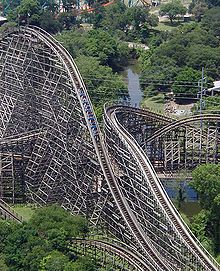Kinetic energy

The cars of a roller coaster reach their maximum kinetic energy when at the bottom of the path. When they start rising, the kinetic energy begins to be converted to gravitational potential energy. The sum of kinetic and potential energy in the system remains constant, ignoring losses to friction.
Common symbols
KE, Ek, or T
SI unit
joule (J)
Derivations from
other quantities
Ek = ½mv2
Ek = Et+Er
In classical mechanics, the kinetic energy of a non-rotating object of mass m traveling at a speed v is {\displaystyle {\begin{smallmatrix}{\frac {1}{2}}mv^{2}\end{smallmatrix}}} {\begin{smallmatrix}{\frac {1}{2}}mv^{2}\end{smallmatrix}}. In relativistic mechanics, this is a good approximation only when v is much less than the speed of light.